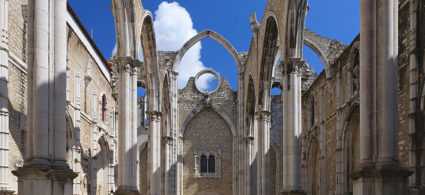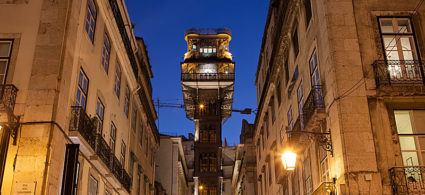

Located between Barrio Alto and Baixa, the Chiado district (pronounced ʃiadu in Portuguese), is one of the historical areas of Lisbon. It is characterized by a series of boulevards, some of which are pedestrians, others are filled with shops, hotels, and coffee shops, although the main shopping street of the area is Rua Garrett, formerly known as rua Chiado.
Chiado is not too big and it is easy to walk around. Churches, museums, theaters, and panoramic viewpoints are the main attractions of this historical neighborhood. Once you have finished your visit, you can enjoy some shopping at one of the many shops and malls in the area.
Begin your stroll around Chiado by visiting the ruins of Carmo Convent, which used to be Lisbon’s largest Gothic church and which today hosts open air theater performances. The São Roque Church is the baroque masterpiece of Lisbon; the facade is austere but it will surprise you with its interiors filled with marbles, golds, paintings, and azulejos.
In the adjacent Museo de São Roque you can admire a collection of liturgical objects. You can also find some other ecclesiastical treasures at the Museu Arqueológico do Carmo, even if most of tourists come here to see something even more interesting; three mummies, one from Egypt and two from Peru. The Museu do Chiado on the other hand exhibits a collection of Portuguese and international works from the 9th and the 10th century; in addiction, it also hosts some contemporary art temporary exhibitions .
The Teatro Naciónal de São Carlos is one of the restored palaces after the fire of 1988; it opened its doors towards the end of 1700 and its interior is richly decorated with rococò style motifs.
From Chiado you can easily reach Baixa and Barrio Alto. In the first case you should take the Elevador de Santa Justa: as you move, pay attention to this masterpiece of art and engineering. The easiest way to reach Barrio Alto is by taking the Elevador da Glória at Praça dos Restauradores: once you get off the lift reach the Miradouro de São Pedro de Alcantara and enjoy one of the most beautiful views on the seven hills of Lisbon.
One of the most interesting ways to explore the neighbourhood is by taking part in a guided tour.
Today Lisbonians come here to go shopping and drink some coffee, while tourists can choose among a wide offer of hotels and accommodations. Back in the days this district was a meeting point for writers and intellectuals, especially towards the end of the XIX and the beginning of the XX century, when they gathered to talk about literature, art, and politics. Among these characters, there was António Ribeiro, also known as Chiado (the name of the district probably comes from his nickname), and poet Fernando Pessoa who was born here.
The literary and artistic past of the neighborhood is still tangible around the alleys and boulevards of the area. The regular customers of the historical café La Brasileira are greeted by the bronze statue of Fernando Pessoa sitting at one of the typical hexagonal tables just outside the cafe. Another statue that pays tribute to the literary past of the district is the one featuring the poet Luís de Camões.
There are many theaters in the Chiado district, including some historical theaters like the São Luiz Teatro Municipal, Teatro da Trindade and Teatro Naciónal de São Carlos.
In 1755 Lisbon was hit by a devastating fire, and then in 1988 another horrible fire burned out a store and spread through Chiado, provoking several damages, destroying 18 buildings, and causing two casualties.
It was impossible for firefighters to pass through the narrow streets where the fire burned out. The episode painfully marked the collective memory of Chiado’s residents, and traces of the fire can still be seen in some buildings. In spite of what happened, Chiado has proudly managed to start over again and restore its palaces following the directions of Álvaro Siza Vieira, one of the biggest architects of Portugal. The neighborhood came back to shine as one of the most elegant areas of the city.
City Card allow you to save on public transport and / or on the entrances to the main tourist attractions.



